
Scots Uniting Church, Heidelberg: exterior
[photograph from church website]

Scots Uniting Church, Heidelberg: exterior
[photograph from church website]
Historical and Technical Documentation by John Maidment
© OHTA (last updated January 2015)
The first Presbyterian services in the area were held as far back as 1843.1 The present church building, built of brick in the Early English Gothic style, was opened on 14 April 1901.2
The organ was built in 1929 by the Aeolian Company, New York, for the residence of William A. Raymond, who first lived at Studley Road, Ivanhoe and later at 16 and 27 Carn Avenue, Ivanhoe.3 The book The Aeolian Pipe Organ and its Music records that the organ was Aeolian job number 1743 and the last of the Aeolian organs sent to Australia from the firm's New York premises. It was a two manual organ of six ranks fitted with a harp stop. The contract was received on 26 July 1929 and it was shipped on 13 August 1929 - an extraordinary feat! Maybe the instrument was fully complete. The cost was £3,613 (US$7,285.25)4.
Raymond was a successful manufacturer of leather goods. His brother Reginald A. Raymond had a three-manual organ of 25 speaking stops built in 1927 by George Fincham & Sons in the basement of his nearby home in Warringal Place, Heidelberg (parts of which were utilised by the Fincham firm in their enlargement of the organ at the Baptist Church, Hobart). William Raymond died on 9 September 1950, aged 695 and it was reported in October 1950 that W.A. Raymond, company director of Carn Avenue, Ivanhoe had left an estate valued at £118,000.6
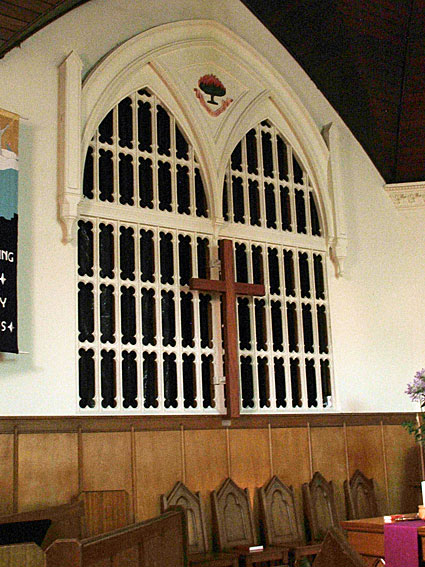
Scots Uniting Church, Heidelberg: organ grille
[photograph by Daniel Bittner (December 2014)]
The Aeolian organ was installed at Scots Church by George Fincham & Sons Pty Ltd and dedicated on 28 September 1952, the opening recital given by Lawrence E. Warner. The cost of acquiring and installing the organ was £2,000.7 The church built a special chamber at the front of the church to accommodate the Aeolian organ, the sound issuing through Perpendicular Gothic traceried plaster grilles. George Fincham & Sons added an Open Diapason rank at this time.
Apart from this addition, and the removal of the roll-playing mechanism (and discarding of the rolls), the organ has remained intact, retaining its unusual piano style console, stopkeys, windchests, wind system (including two single-rise reservoirs), and electro-pneumatic action (including relays and switching system). The instrument was classified by the National Trust of Australia (Victoria) in December 1991, the citation reading:
"Apart from the removal of the original roll-playing mechanism, and the addition of a new rank of pipes, the instrument remains largely intact, retaining its original action, console and pipework, and is the only example of the firm's work in Victoria to remain largely unaltered."
It is now thought to be the only example of the firm's work in Australia to remain in recognisable form, retaining the original console.
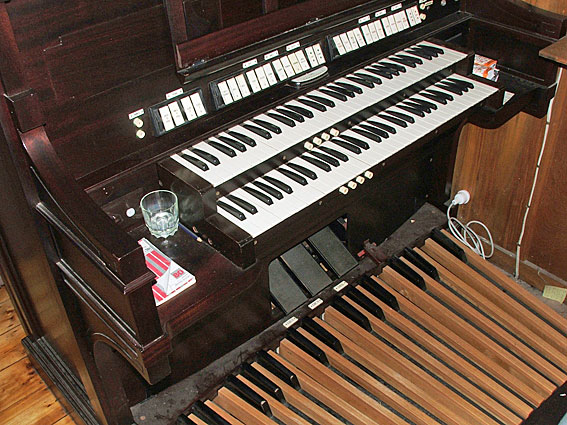
Scots Uniting Church, Heidelberg: console
[photograph by Daniel Bittner (December 2014)]
The organ is entirely enclosed in a large swell chamber divided centrally to provide two expressive divisions (Expression I and Expression II). The pipework and mechanisms are uniformly of superlative quality. The wooden structural components are painted in yellow ochre - the Aeolian house paint colour. The instrument currently has seven ranks: Flute 16 (pedal), Open Diapason 8, Wood Diapason 8 (labelled Grosse Flute on the rackboard), Flute 4 (stopped wood), String 8 (labelled Sal[icional] on the pipes), Celeste 8, Clarinet (free reed) 8.

Scots Uniting Church, Heidelberg: stopkeys 1
[photograph by Daniel Bittner (December 2014)]
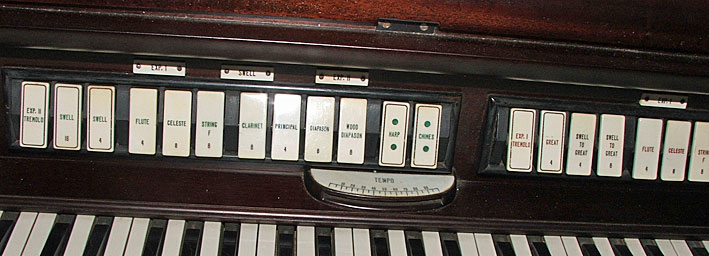
Scots Uniting Church, Heidelberg: stopkeys 2
[photograph by Daniel Bittner (December 2014)]

Scots Uniting Church, Heidelberg: stopkeys 3
[photograph by Daniel Bittner (December 2014)]
PEDAL |
16 8 16 4 4 8 8 8 4 8 8 |
(stops have duplicate controls for each manual) |
Fixed thumb pistons placed under each manual labelled: O, P, M, F
Balanced pedals labelled: Exp I, Exp II, Cresc
Chimes: P, F
Harp: P, F8
The organ was restored by Australian Pipe Organs Pty Ltd in 2002-2003. This included the complete overhaul of the console, particularly restoration of the keyboards and pedal board, and the mahogany woodwork. An adjustable piston action has been fitted behind the doors that originally accommodated the roll playing mechanism. The switches and relays have been fully overhauled and the entire organ rewired with new cabling. The duplex action windchests and reservoirs have also been overhauled. The pipework was carefully cleaned and regulated. The internal yellow ochre paint colour has been preserved.9
This is a very rare example of an early organ with electro-pneumatic action surviving largely unaltered.

Scots Uniting Church, Heidelberg: nameplate
[photograph by Daniel Bittner (December 2014)]

Scots Uniting Church, Heidelberg: swell and crescendo pedals
[photograph by Daniel Bittner (December 2014)]
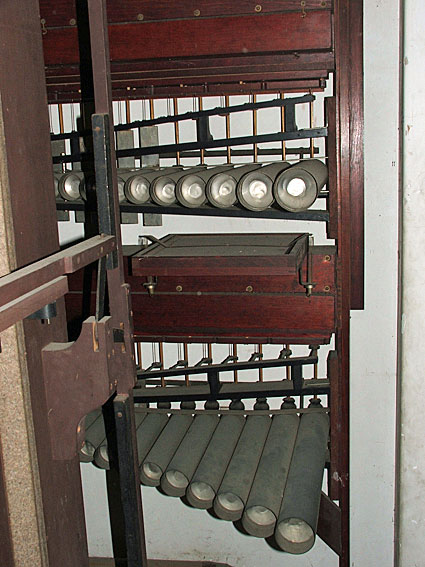
Scots Uniting Church, Heidelberg: harp
[photograph by Daniel Bittner (December 2014)]
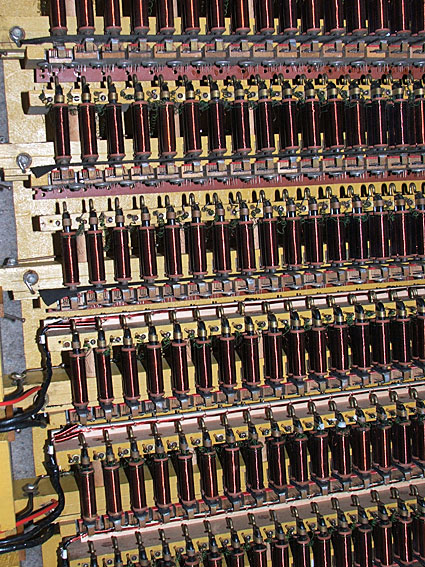
Scots Uniting Church, Heidelberg: relays & switchgear 1
[photograph by Daniel Bittner (December 2014)]

Scots Uniting Church, Heidelberg: relays & switchgear 2
[photograph by Daniel Bittner (December 2014)]
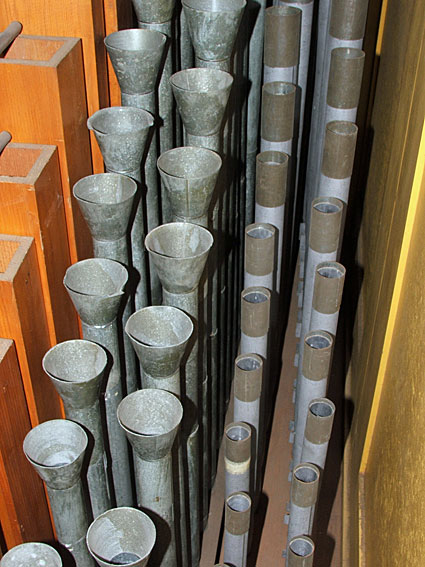
Scots Uniting Church, Heidelberg: wood Diapason, Clarinet and metal Diapason
[photograph by Daniel Bittner (December 2014)]
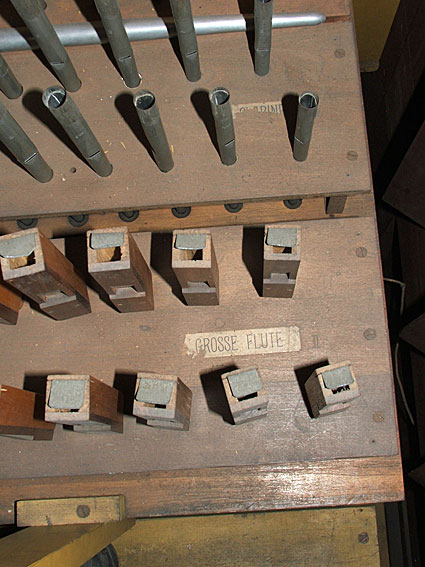
Scots Uniting Church, Heidelberg: labels on rackboards
[photograph by Daniel Bittner (December 2014)]
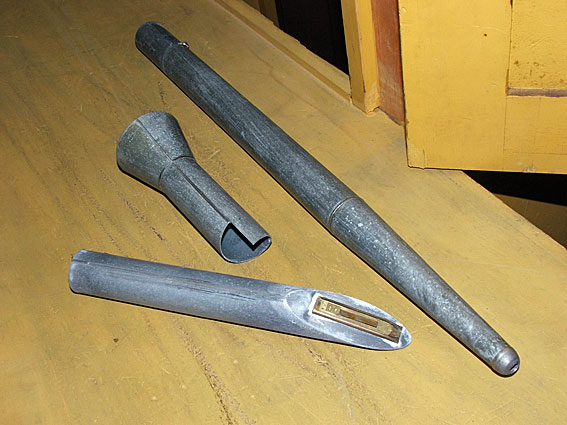
Scots Uniting Church, Heidelberg: Clarinet showing free reed
[photograph by Daniel Bittner (December 2014)]
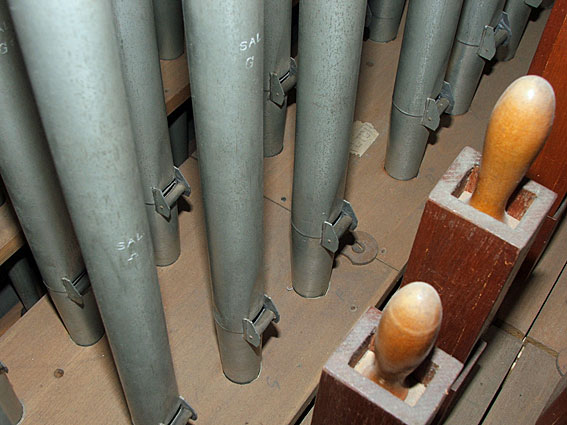
Scots Uniting Church, Heidelberg: string bass showing roller beards, and stopped Flute
[photograph by Daniel Bittner (December 2014)]
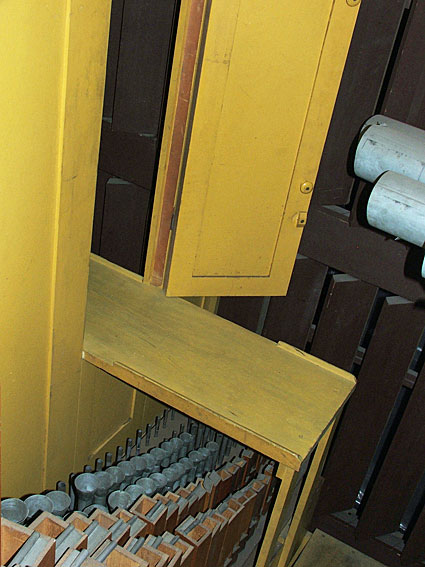
Scots Uniting Church, Heidelberg: passage board, swell box door and shutters
[photograph by Daniel Bittner (December 2014)]
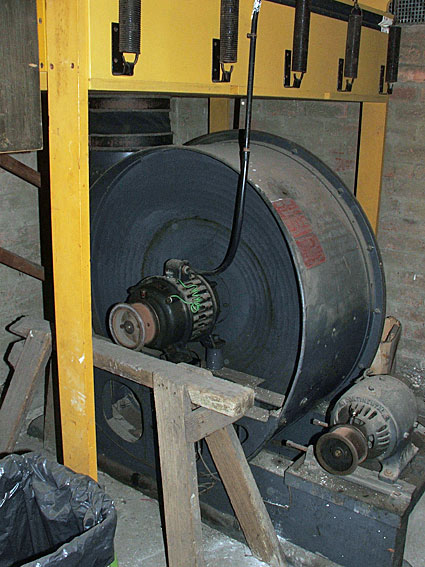
Scots Uniting Church, Heidelberg: Spencer Orgoblo and wind regulator
[photograph by Daniel Bittner (December 2014)]
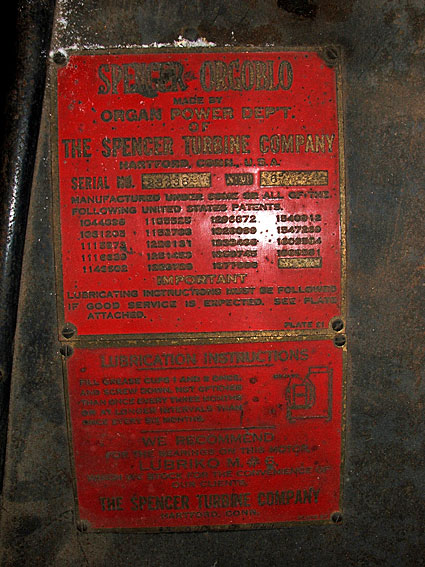
Scots Uniting Church, Heidelberg: blower label showing instructions
[photograph by Daniel Bittner (December 2014)]
1 The Argus, 9 December 1912, p.9
2 The Argus, 21 December 1907, p.19
3 Sands & McDougalls Directories
4 Rollin Smith, The Aeolian Pipe Organ and its Music (Richmond, Virginia: The Organ Historical Society, 1998), p.380
5 The Argus, 12 September 1950, p.14
6 The Argus, 25 October 1950, p.5
7 The Argus, 27 September 1952, p.15
8 Details noted by John Maidment 2003
9 Details noted by John Maidment 2003 who was an advisor to the church on the organ restoration